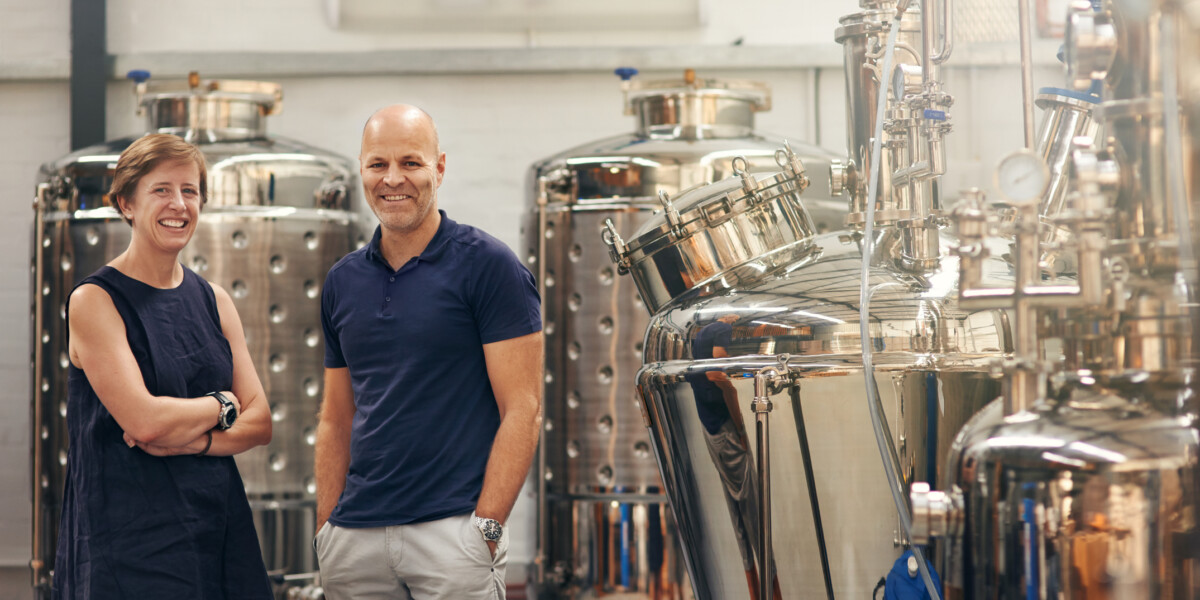By Jon Reynolds

Michelle Forster is the Executive Director of the Wyoming Brewers Guild and the facilitator in UVM’s Business of Craft Beer Professional Certificate Program. She brings a unique perspective to UVM’s craft beer program as she draws on experience and insights from the 25 active craft breweries in Wyoming.
We recently caught up with Michelle to talk about current trends in the craft brewing industry.
JR: Michelle, can you give a brief overview of your experience in the craft brewing industry?
MF: I came from Los Angeles to the craft brewing Industry with experience in classical music and title insurance. I have a strong industry background in consulting, strategic planning, social media, distribution, annual beer summits, and managing 25 active craft breweries at the Wyoming Brewers Guild (WYBG). I joined the UVM Business of Craft Beer team seven years ago as a facilitator for the certificate program to support students with their weekly discussion posts, communications, software and technology issues, assignments, updates, and any changes to the course.
JR: Why do you think the UVM BOCB program is key to business success for craft brewers?
MF: Joining Craft beer as a new brewer today requires a high degree of business acumen, with constant innovation. Your brewery’s expertise must cover all aspects of business, including finance, operations, marketing/social media, sales, and branding. You can’t open a brewery in a garage today and expect to be successful. You need to dig into areas that are uncomfortable to some—cash flow management, financial ratios, digital media, and supply chain management; and you can do that through the UVM business of craft beer program.
JR: You recently held an Annual Beer Summit in your home state of Wyoming. Can you give us a brief overview of what took place at this Summit and what you learned from the brewers who attended?
MF: Basically, the 2021 WY Brewers Guild Summit was a mini Craft Brewers Conference. The program’s platform #1 goal was to provide education for all of the breweries. The program also included seminars on finance, cash flow, diversity/equity inclusion, marketing/branding, and supply chain issues like ingredients (international malts, hops and superfruits), cans, and cardboard. Diversity, equity and inclusion training was also part of the Summit’s program. Guest speakers came from long distances and some were current instructors for the BOCB courses who I met as part of the UVM program. The WY Brewers Guild Summit will be held in Casper, WY, September 8-9, 2022.
JR: With nearly 9,000 craft brewers recognized by the Brewers Association in business today, is there room for more? What do you see from your Wyoming perspective of why more craft brewers can fit into your state?
MF: The major challenge for Wyoming breweries is long distance between cities and associated freight costs to service. Our state per capita for breweries is quite high compared to other states, simply because we don’t have the population base, but have a great craft beer following. If new breweries want to open in Wyoming, they most likely would not be packaging breweries, but rather hyper-local Taprooms or Brewpubs. Craft beer is still growing in Wyoming and I believe this will provide more room for future brewers.
“Breweries often begin as passion projects and that’s part of what makes this industry so special. But without a square head for business, breweries risk failure.”
MICHELLE FORSTER, EXECUTIVE DIRECTOR WYOMING BREWERS GUILD
JR: What do you see as the most exciting aspects of craft beer?
MF: The craft beer industry is constantly changing and the WY players are always thinking on how to do it better and adapt to these changes. Whether it pertains to supply chain issues, labor shortages, COVID rules, or new competition, the WY Craft Brewers meet change and challenges head-on. Their common belief is that “Craft Beer is Good” and “So Are the People In It.” The WY Brewers Guild provides a framework to work on these challenges together.
JR: Are taprooms evolving into new locations where they can stand out rather than in new business development centers, strip malls or neighborhoods? What do you see in Wyoming?
MF: The movement in Wyoming is counter to most states in the country with most new craft breweries opening as part of downtown revitalization projects, rather than in suburban or rural locations. Many of the new WY craft breweries are in towns with population over 10,000 people and some are existing craft brewers building their second or third location in growth markets like Jackson Hole and Casper, WY. State law requires 50 barrels minimum brew size for each brewery location, but this can easily be met with a small brewing facility and a taproom. Craft breweries do exist in some seasonal locations like lodges or ski hills, but seasonality in WY makes these locations difficult to maintain profitability in the off season.
JR: What do you see as the major challenges for craft brewers in 2022?
MF: Here are the Top 3 Challenges for Wyoming Craft Brewers in 2022:
- Room in the market—both in the cooler and on the warm shelf, plus taphandles on-premise. WY already has a high index for breweries in our largest markets.
- Aluminum can shortages—this is a nationwide problem but affects the smaller players because they are not protected with long term contracts beyond the first half of 2022. Craft beer does not have enough can supply, even with the new aluminum can plants under construction by Ball, Trivium-Ardaugh, American Can and Crown right now. This will cause craft brewers to pay higher prices for cans to distributors, instead of buying directly from the manufacturer.
- Draught and Alternative Vessels—while the Brewers will try to make up lost 12/16 oz can business with draught, bottles and larger size vessels, many in WY have already sold their bottle lines, thus not being able to pivot to glass bottles. Also, while there are many on-premise venues re-opening post-COVID, the taplines in many of these accounts are not all being offered back to craft brewers because the bar and restaurant owners do not wish to get stuck with unsold kegs if the pandemic raises its head again. This causes many of the craft brewers to focus on cans to get on-premise business, which has been pointed out are in high demand and low supply for these breweries—a vicious short-term cycle for brewers to find solutions for.

JR: What do you see as the largest challenge for new craft brewers? Some thoughts include employees, innovation, cash for operations, UPS strategy, location/traffic, or branding/marketing.
MF: There are many hot buttons for craft brewers to push. #1 button to push is cash, cash and cash—too many brewers never have enough cash to manage their operations. #2 button is lack of people-power and sourcing managerial talent—distributors, restaurants and bars face the same issue in many locations across Wyoming. #3 button is Marketing/Brand identity—to have a chance to break-through, the craft breweries need to have a clear point of difference or POD. Many craft brewers do not think about their unique selling point or USP and branding enough to stand out. This is an area that many need to hire experienced designers or branding experts to help them create a winning branding strategy for their brewery and then compliment that with a social media plan that gets their name out.
JR: Where do you see the craft beer industry heading in the next few years? Are craft brewers well-positioned to compete against everything being thrown at them?
MF: The Gen Z’ers are experience-oriented and this is causing changes in the beverage styles that they are drinking. Their choices are hard seltzers, RTD beverages, cannabis drinks, Kombucha, and non-alcoholic craft beers, and hop waters. Innovation and diversification is key to future jobs and economic impact. Today’s craft brewers need to stay relevant and open to alternative beverages. This requires extensive market research and constant innovation and trial; taprooms allow for this.
The one thing that will and always kept this industry going through dynamic challenges and shifting trends is its commitment to the core values of quality, innovation, and community. Breweries cannot afford to lose sight of those values no matter what the market demands. Staying relevant by being open to new and diverse product offerings will only work if the foundation of who we are and why we do what we do remains intact.
JR: There is a huge movement by craft brewers centered around the #MeTooMovement which is focused on sexual harassment, discrimination, and toxic masculinity within the male-dominated craft brewing industry. Stories have been covered in media outlets Good Beer Hunting, eater.com, Bon Appetit, and the Boston Globe. How does this affect the future of craft breweries and how they set standards and rules in the human resource area for equal treatment of all employees, no matter what their sex, race or origin?
MF: I see this as a phenomenal opportunity for the craft beer industry to self-reflect and lead. As business owners who are always responding to shifts in the market, breweries know that change is hard, good and necessary.
This kind of change begins with difficult conversations in the brewery which can include questions like:
- What do we want our brewery to be?
- Where are we falling short when it comes to employee safety and well-being?
- What are our blind spots?
- What are we passionate about?
- What happens if we do nothing and don’t take any action?
Many brewers are moving quickly to introduce Diversity, Equity, and Inclusion into their Code of Conduct Policy and also to provide safe and anonymous reporting portals for employees who have experienced harassment. This is a good start. The follow-through and continual commitment will be critical. Failure to take action will and has resulted in an unsafe, toxic, and uncomfortable work environment for thousands of brewery employees and it’s past time for that to STOP. The key is to introduce ways to look at things differently and then commit to new policies that foster change and provide respect and kindness for all employees. This has been a long time coming, but it is moving in the right direction.
JR: Tell us what type of background is important in the craft brewing industry and how does it help with brewery’s long-term potential? What do you see as personality traits or character do you see as the best fit for a new craft brewer?
MF: Many new employees in craft beer come from outside of the beer industry. I like to think of them having curiosity without fear. They have courage and are unafraid of failing and will rise again if they do. They have tremendous versatility and a tireless work ethic and are building a track record of success. Today’s young, energetic employees have several traits that will help down that path to success, including integrity, honesty, loyalty, respect, responsibility, compassion, and self-discipline. They believe in something and are willing to work harder to prove it.
In addition to these personality traits, it is critical that anyone interested in owning or managing a brewery be prepared to make tough business decisions. Breweries often begin as passion projects and that’s part of what makes this industry so special. But without a square head for business, breweries risk failure. Be curious, read, research, learn – ask questions of people smarter than you. You have to be fearless in ALL aspects of this industry!
Learn from more craft brewing industry experts in the UVM Business of Craft Beer Professional Certificate today.

Jon Reynolds is the founder of Brewplan, a strategic marketing advisor to craft brewers, craft distilleries, boutique wineries, and a Certified Instructor in the UVM Business of Craft Beer Professional Certificate Program. He writes about business trends, beer consumers, distributor issues, legislation that affects craft brewers, marketing tools, and strategic planning to improve brewery profits.
Views and opinions expressed herein are those of the author who has spent more than 40+ years in the beer, wine and spirits industry and are provided for informational purposes only. The information set forth reflects the author’s opinion of current trends in the industry and should be researched further to make your own business conclusions.




